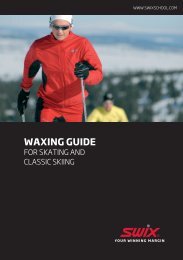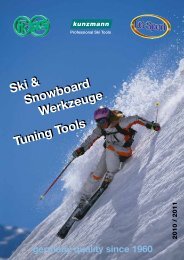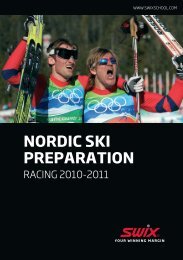ALPINE SKI & SNOWBOARD PREPARATION
ALPINE SKI & SNOWBOARD PREPARATION
ALPINE SKI & SNOWBOARD PREPARATION
Create successful ePaper yourself
Turn your PDF publications into a flip-book with our unique Google optimized e-Paper software.
PREPARING EDGES ON<br />
<strong>SNOWBOARD</strong>S<br />
IN GENERAL<br />
The set-up of the edges depends upon the type<br />
of board, properties of the board, usage of the<br />
board, the snowboarder’s technical skills and<br />
the ability to feel the kind of snow he/she is on.<br />
The set-up of the edges must be adapted to<br />
each individual. The best results will be achieved<br />
through testing and experiencing different snow<br />
conditions. Both edges of the snowboard should<br />
be treated equally and can be adjusted later when<br />
the board has been tested on snow. To make<br />
sure that the board performs perfectly on snow<br />
and ice, the edge has to be even and polished<br />
without scratches or other damage. If the board<br />
has been used on rails, the edge could be tempered<br />
and almost impossible to file. In this case,<br />
stone grinding is highly recommended. To ensure<br />
optimal glide and to benefit from the properties<br />
of the board, the base-side edges has to be even<br />
with the base. If the base of the board is not completely<br />
flat, a qualified technician can do this with<br />
a good stone grinding machine. The right tools are<br />
important and practical for a good result.<br />
Top quality snowboard-vises like the Swix SB31XF<br />
are a good start in combination with other tools.<br />
This will be mentioned later. Keeping your work<br />
place and tools clean is essential for the best<br />
results. Procedures and the use of different tools<br />
are described step by step from page 37.<br />
BASE-SIDE EDGES - <strong>PREPARATION</strong> AND FILING<br />
To make the snowboard easy to use, the edge<br />
has to be beveled. This means that we give the<br />
base-side of the edge a certain, fixed angle (see<br />
illustration page 9).<br />
By beveling the edges, will give the following<br />
benefits:<br />
• The edge has a slight angle to the surface and<br />
will carve more progressively.<br />
• The board will be easier to turn and control.<br />
• The edge will be less aggressive sideways<br />
towards the snow. The result will be less risk of<br />
catching an edge and losing control. This is very<br />
important.<br />
• Rotations will feel easier and the ride will have<br />
a better flow.<br />
Tools that are used for preparing the base-side<br />
edges are Swix TA05, Swix TA075, Swix TA010 or<br />
Swix TA0515.<br />
PLANING AND PREPARING THE BOARDS<br />
SIDEWALLS<br />
The sidewall of a snowboard normally has a thin<br />
plastic directly above the steel edge This needs<br />
to be removed in order to do get the best results<br />
after filing on sidewall-side edges. By removing a<br />
small portion of this edge with a specialized planer,<br />
the risk of getting plastic in the files is reduced.<br />
This small plastic side-edge gives support to the<br />
steel edge and it is important that it is removed<br />
gradually. There may be a thin sheet of metal<br />
above the steel edge on some snowboards, This is<br />
removed together with the plastic with the same<br />
tool. We recommend using the specially designed<br />
planer for this. The planer blade is either round<br />
or square. Swix TA100R (round) is normally used<br />
on boards with a cap construction, while the Swix<br />
TA100SB (square) is used on traditional sandwich<br />
constructions. Use the “panzer” file Swix T108 to<br />
get a smooth and even surface on the sidewall.<br />
To finish off, use a fine Swix T350 silicone-carbide<br />
paper # 180 and Swix Fibertex T264. This is<br />
exclusively done on the sidewalls and not on the<br />
steel edges. (See illustration page 39.)<br />
FILING AND PREPARING THE SIDEWALL-SIDE<br />
EDGES<br />
The sidewall-side of the steel edge is also beveled<br />
to give better grip on hard snow and ice.<br />
The sharper the angle between the sidewall-side<br />
and the base-side of the edge, the more “aggressive”<br />
the grip on the snow will be.<br />
Normally 2 - 3 degrees are used. Tools for this<br />
use are Swix TA288, Swix TA287, Swix TA388,<br />
Swix TA387 and Swix TA3003. (See pictures page<br />
11.)<br />
DEBURRING THE BASE-SIDE AND SIDEWALL-<br />
SIDE EDGES<br />
There will always be small burrs after working<br />
with the file on the edges. To prevent the edge<br />
from getting dull because these burrs tend to<br />
break away the point of the angle causing the<br />
edges to become dull sooner. By using the Swix<br />
coarse diamond stone Swix TAA200 or the Swix<br />
rubber stone, Swix T994, these small burrs are<br />
easily removed. (See page 39.)<br />
DAILY MAINTENANCE<br />
Small adjustments and improvements can be<br />
obtained by polishing the edges. Edges that are<br />
polished are faster, sharper and will stay sharper<br />
longer.<br />
Polishing the edges after each day so that<br />
the board is ready for the next day, means less<br />
time is spent on maintenance. On icy conditions,<br />
it could be necessary to bring a file holder for the<br />
sidewall-side edge with a diamond stone to polish<br />
the edges between each run.<br />
Polish back and forth along the steel-edge<br />
(see illustration #4 page 42). Next, the base-side<br />
of the edge is polished (see illustration #6 page<br />
39).<br />
If this is not enough to make the edges sharp,<br />
a new base prep is needed. Do as described earlier.<br />
Finish of the new base prep by polishing the<br />
edges.<br />
DETUNING AND ADJUSTING STEEL EDGES<br />
To get the full benefit of modern boards, it is recommended<br />
that the edges are sharp across the<br />
full length of the edge. This ensures a good carve<br />
from the tip to the tail of the board. On steep<br />
slopes, a little extra pressure on the nose will start<br />
the turn more easily. To achieve this, the nose<br />
needs to be sharp. If the board feels too aggressive<br />
into the turn or it is difficult to finish the turn,<br />
195 - 255 mm<br />
<strong>SNOWBOARD</strong> VISE (SB031XF)<br />
Simple two piece vise for vertical and horizontal<br />
use.<br />
4 5





